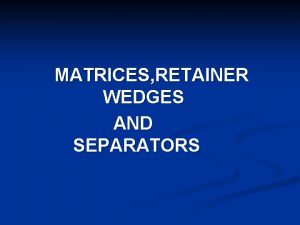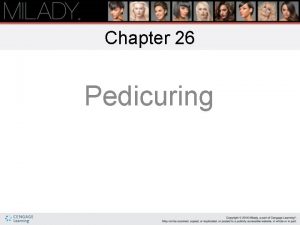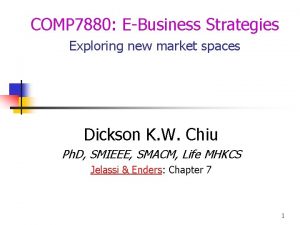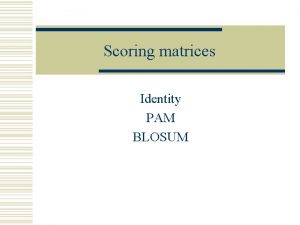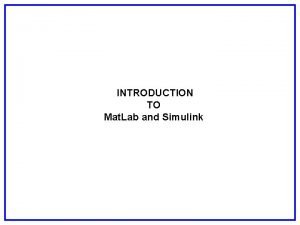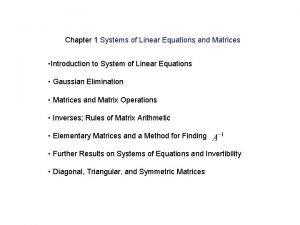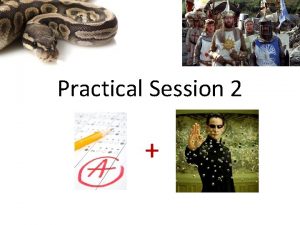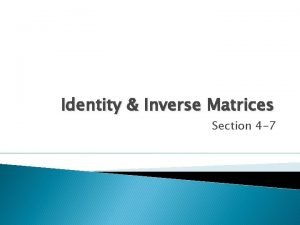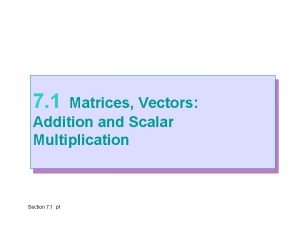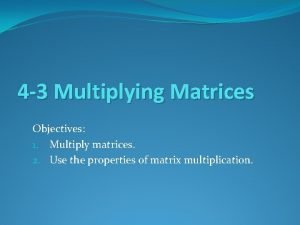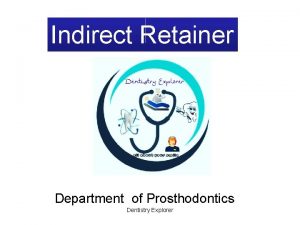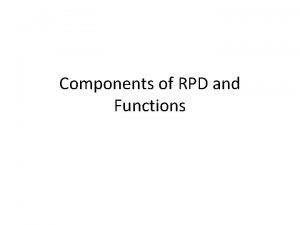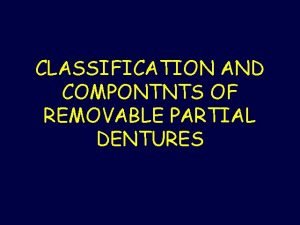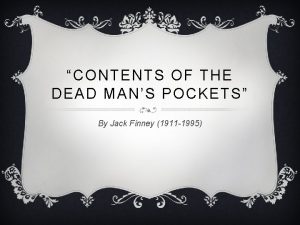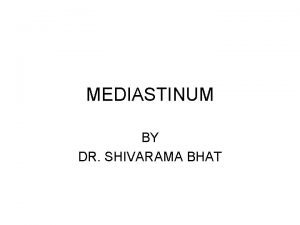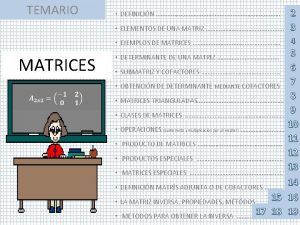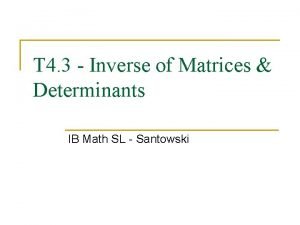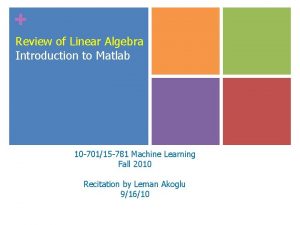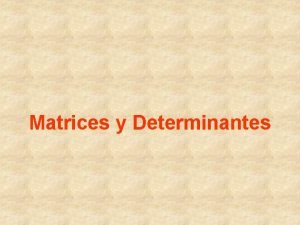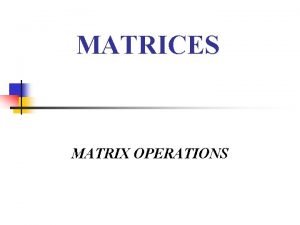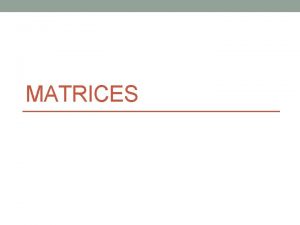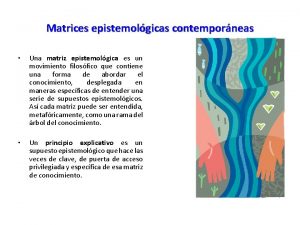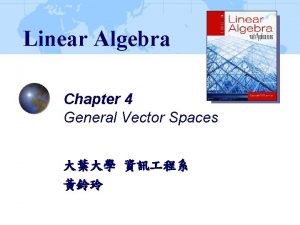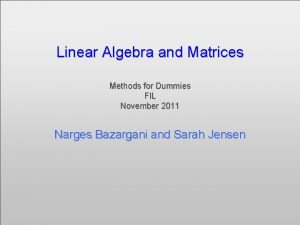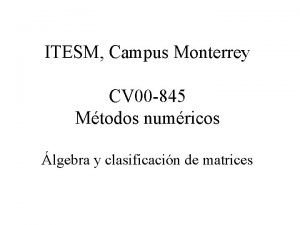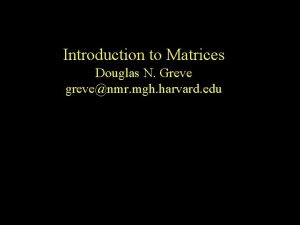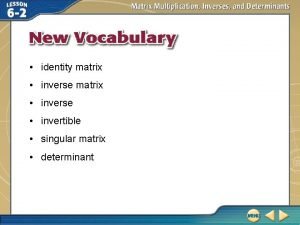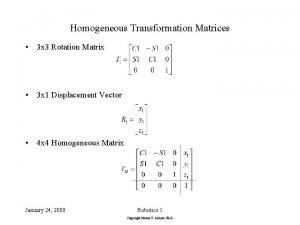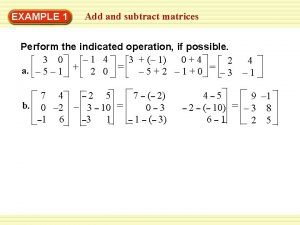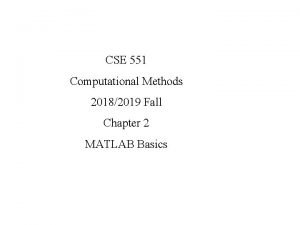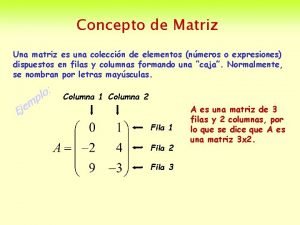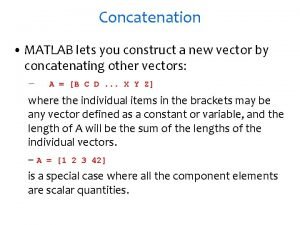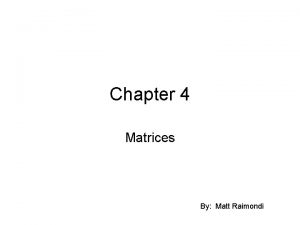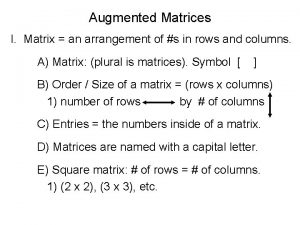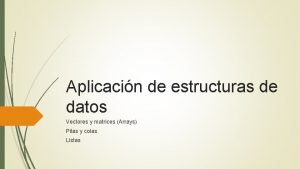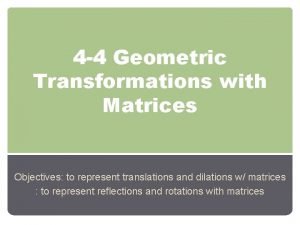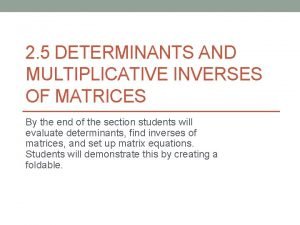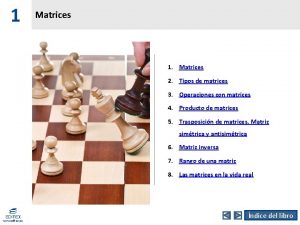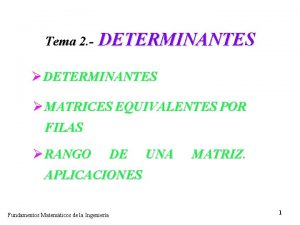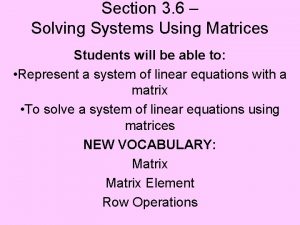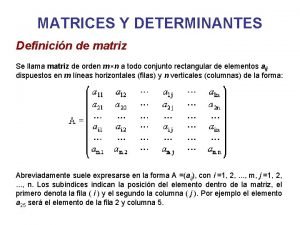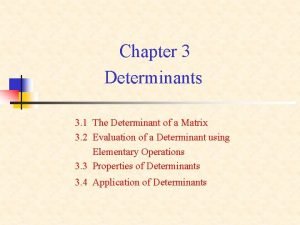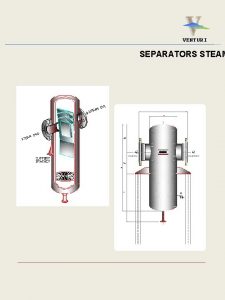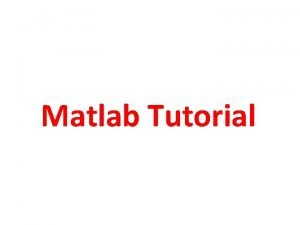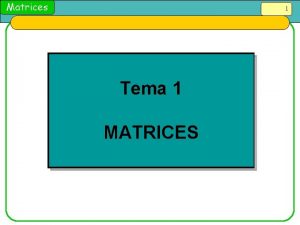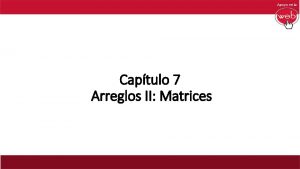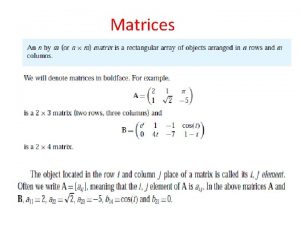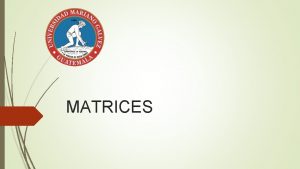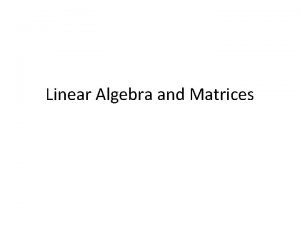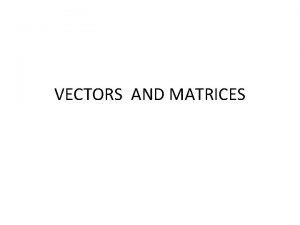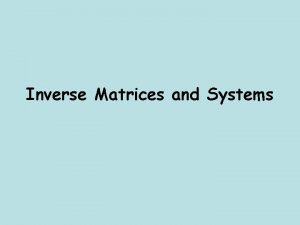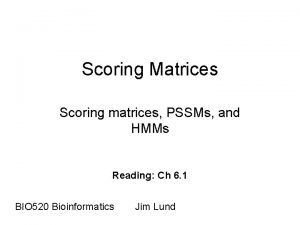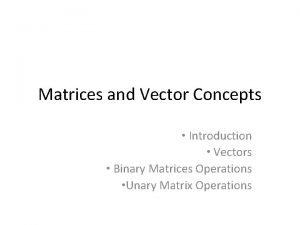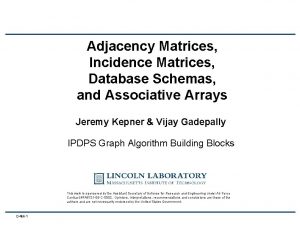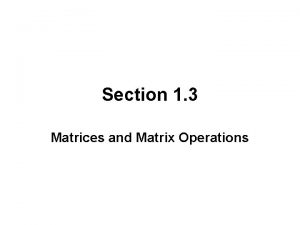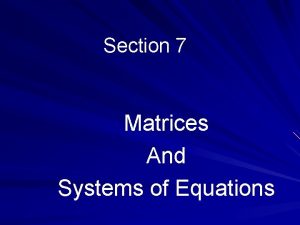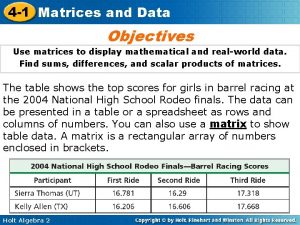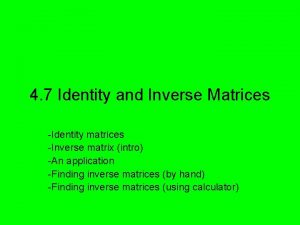MATRICES RETAINER WEDGES AND SEPARATORS CONTENTS WEDGES n



































































- Slides: 67

MATRICES, RETAINER WEDGES AND SEPARATORS

CONTENTS WEDGES n n n INTRODUCTION CLASSIFICATIONS FUNCTIONS WEDGE PLACEMENT TYPES OF WEDGING SEPARATORS USES n PRINCIPAL METHODS - RAPID SEPARATORS - SLOW SEPARATORS n

MATRIX BAND RETAINER n n n n INTRODUCTION DEFINITION SPECIFICATION PURPOSE OF MATRIX CLASSIFICATION PROCEDURE ADVANTAGES AND DISADVANTAGES

MATRICES AND RETAINERS The word matrix derived from the latin mater, mother. “ That which contains and gives form to anything”. - The New Standard Dictionary of the English language Dental Matrix is a properly shaped piece of metal, or other material, used to support and give form to the restoration during its introduction and hardening. First introduced by Dr. Louis jack in 1871. Matricing : Is the procedure where by a temporary wall is created opposite to axial walls surrounding areas of tooth structure that were lost during

SPECIFICATION OF MATRIX BANDS 1. Ease of application 2. Not be cumbersome 3. Easy to remove 4. Rigidity 5. Versatility (Easy adaptability and fixedness to the teeth) 6. Height 7. Proximal contour

PURPOSE OF MATRIX BAND 1. Act as a temporary wall. 2. Re-establishment of contact. 3. Restrict extrusion of the restorative material and prevents overhangs. 4. Provide physiologic contour for proximal surface of restoration. 5. Assist in holding back gingiva & rubber dam during restoration. 6. Maintain the form of restoration during hardening

CLASSIFICATION Based on the cavity preparations done 1. Matrices for class I cavity preparations - Double banded tofflemire retainer. 2. Matrices for class II cavity preparations - Single banded toffelmire. - Ivory matrix no. 1 (unilateral class II) - Ivory matrix no. 8 (Bilateral class II) - Black’s matrices - Seamless copper band or soldered band matrices - Anatomic matrix - Automatrix ( Roll – in band matrix ) - S – shaped matrix.

3. Matrices for a cavity preparation for amalgam restorations on the distal of cuspid. - S - shaped matrix - Toffelmire

4. Matrices for class III cavity preparations for direct tooth colored materials - Mylar strips or Plastic strips 5. Matrices for class IV cavity preparations for direct tooth colored materials - Plastic strip - Aluminium foil incisal corner matrix - Transparent crown form matrices - Anatomic matrix - Modified S - shaped matrix

6. Matrices for class V amalgam restorations - Window matrix - S-shaped matrix 7. Matrices for class V cavity preparations for direct tooth colored materials - Anatomic matrix for non – light cured, direct tooth colored materials - Aluminium or copper collars for non – light cured, direct tooth colored restorative materials - Anatomic matrix for light and non – light cured, direct tooth colored materials.

Based on the materials used 1. Plastic - Mylar strip - Cellulose strip - Hawe Neo’s plastic cervical matrix 2. Metallic a) With retainers - Ivory no. 1 - Ivory no. 8 - Toffelmire matrix band b) Without retainers -Automatrix - S band - T band - Black’s matrix - Copper band - Anatomic matrix

UNIVERSAL OR TOFFELMIRE MATRIX RETAINER AND BANDS Straight and contrangled Convoluted and pre contoured bands

Parts of TOFFELMIRE MATRIX RETAINER n Small knurled nut n Large knurled nut n Locking vise n Pointed spindle n Head—open end and closed end n

Slot facing gingivally and retainer parallel to buccal surfaces of the teeth Incorrect

Matrix band burnishing Beaver tail burnisher or Ball burnisher or Egg shaped burnisher

Trimming occlusal height of the matrix band with the help of crown sheers. Reflecting the handle to permit insertion of mesial wedge on retainer side.


Matrix band removal Removal of the handle; stabilizing the band with the fingers while releasing the knob insures against fracture of the soft amalgam Removal of band in angular direction

Ivory no 1 - For unilateral class II preparations -The band is attached to the retainer via a wedge shaped projection which engages with the tooth at the embrasure of the unprepared surface

Ivory no 8 - For bi-lateral class II ( MOD) preparations - The band encircles the entire crown of the tooth

BLACK’S MATRIX - For class II designs Left : For simple cases Right : with gingival extensions

Auto matrix system • Automatrix is very useful for cusp restorations and class II designs. • They are available in narrow & wide regular, medium thin & med. Regular • Height - 3/16 th to 5/16 th inches (4. 7 - 7. 9 mm) • The tightening ratchet is released after it is in position. Advantage : Auto loop can be positioned either on facial or lingual with equal ease Disadvantage : Bands are not pre-contoured and development of physiologic proximal contour is difficult

SEAMLESS COPPER BAND (With out seam or joints) Copper bands of assorted sizes make excellent matrices, but they are cylindrical and do not flare outward to engage distant contact points. They are susceptible to stretching and shaping with contouring pliers after the band has been rendered soft Bands are softened by heating to redness in a flame and quenching in water.

Assorted copper bands, sizes 1 to 20. The size of a No. 1 band is 4 mm in diameter, and the size of a No. 20 band is 12 mm in diameter, with a wall thickness of 0. 15 mm. Bands are softened by holding to redness in a flame and quenching in water.

Pliers for shaping copper band. Left, Contouring pliers to bend the edges of the band Right, Stretching pliers. By pinching the metal the band becomes thinner and spreads apart. Stretching pliers in use to enlarge and contour the sides of the copper band. Reducing the thickness of the band at the region of the contact point with the help of green stone.

Cutting the band off the tooth after the amalgam is sufficiently hardened

ANATOMIC MATRIX This is the most efficient means of reproducing contact and contour. Entirely hand-made and contoured specifically for each individual case. Especially useful in mutilated teeth or teeth requiring unique anatomy to be reproduced in the restoration. A piece of 0. 001 -0. 002" stainless steel matrix band is used. Usually it is supported by compound.

S – SHAPED BAND - Class II designs - Class III on distal of the cuspid with labial or lingual access - For large class V cavities extending in to the proximal areas Contoured area for contact

T – shaped band These are premade T-shaped brass or stainless steel matrix bands. The long arm of the T is bent or curled to encompass the tooth circumferentially and overlap the short horizontal arm of T. This section is then bent over the long arm , loosely holding in place. Wedges and stabilising compound can be applied as in the anatomic matrix to add further stability.

Denovo matrix system

Omni – Matrix System The Omni-Matrix is basically a preassembled Tofflemire retainer and band that is intended for one time use and then disposal.

WINDOW MATRIX SYSTEM These are usually not indicated except for very wide cavities occluso - gingivally and/or mesio-distally, This matrix if formed using either a Tofflemire matrix or copper band matrix. The contrangle retainer is applied at the side of the tooth that does not have the preparation. A window is cut in the band slightly smaller than the outline of the cavity. Wedges are placed mesially and distally & restoration done. Similarly copper band can be used.

Transparent crown form matrices These are "stock" plastic crowns which can be adapted to tooth anatomy. For class IV cavity preparations. In bilateral Class IV preparations use the entire crown form, but in a unilateral Class IV cut the plastic crown inciso - gingivally into two halves and use only the side corresponding to the location of the preparation. Vent hole Thinned contact area

NEW TYPES n Circumferential mylar (contact molar band, ivoclar/vivadent). n Sectional mylar (cervical matrix, centrix, shelton, CT). n Triodent matrix and wedges n Sectional matrix (Palodent, composi-tight by garrison dental solutions, contact matrix rings danville engineering).

SECTIONAL MATRIX SYSTEM Principle : Wedge principle in matrices. Procedure : - Placed in position by rubberdam clamp holder acting as a separator. - As the two ends rest on the teeth, the matrix band is forced against the tooth surface. -The pressure on both sides at the same time gives slight separation, thus aids in obtaining a tight contact.

WEDGES Devices preferred for rapid separation. They are third component of the matrix system.

FUNCTIONS 1. They assure close adaptability of matrix band to the tooth, gingival to the gingival margin of preparation. 2. Protects the interdental col by preventing restoration impingement. 3. Defines the gingival, facial & lingual extent of the contact area.

n . Creates some separation to compensate for the thickness of matrix band. n . Establishes atraumatic retraction of the rubber dam and the gingiva, there by producing a temporary hemostasis and minimizing moisture by adsorption n . Assure immobilization of matrix band during restoration placement. .

CLASSIFICATION 1. Based on the shape : a) Anatomic – For deeply extended gingival margin because its greatest cross-sectional area is at its base. b) Non-anatomic – Preferred with conservative proximal boxes because its wedging action is more occlusal (near gingival margin) 2. Based on material used : a) Wooden wedges – They are easily cut and trimmed and they absorb water intra orally. This causes then to swell improving their inter proximal retention. eg. Rainbow wedges tm b) Resin wedges – They can be plastically molded and bent to correspond with the configuration of the inter dental col. eg. Fintrec transparent wedges.

Depending upon the shape, they are classified as n Triangular (anatomic) wedges ( ) (Triangular in cross section). n Round wedges (O) (Round in cross section)

3. Based on the manufacturing - custom made & - preformed 4. Based on the consistancy - Hard & rigid (oak wood) eg. Wizard wedge - soft and compressible (pine wood) eg. No. Hem

Round toothpick versus triangular i. e. , anatomic wedges. A, The triangular, wedge will not firmly support the matrix band against the gingival margin in conservative Class II preparations (arrow); . B, The round toothpick wedge is preferred because its wedging action is nearer the gingival margin. C, With deep gingival margins, the round toothpick wedge will crimp the matrix band contour if its diameter is above the gingival margin. D, The. triangular wedge is preferred with these preparations because its greatest width is at its base.

Modified triangular i. e, anatomic wedge. A, Depending on proximal convexity, triangular wedge may distort matrix contour. B, A sharp bladed instrument may be used to modify the triangular steepness of the wedge, C, Modified and unmodified wedges compared, D, Properly modified triangular wedge prevents distortion of matrix contour.


PROCEDURE Break off approximately ½ inch (1. 2 cm) of a round toothpick. Grasp the broken end of the wedge with the No. 110 pliers. Insert the pointed tip from the lingual or facial embrasure (whichever is larger), slightly gingival to the gingival margin. Wedge the band tightly against the tooth and margin. If necessary, the gingival aspect of the wedge may be slightly wetted with lubricant to facilitate its placement.

If the wedge is placed occlusal to the gingival margin, the band will be pressed into the preparation, creating an abnormal concavity in the proximal surface of the restoration. The wedge should not be so far apical to the gingival margin that the band will not be held tightly against the gingival margin. This improper wedge placement will result in gingival excess (i. e. , overhang )

Supporting matrix with blade of Hollenback carver during wedge insertion. Custom made tongue blade wedge may be used when excessive space exists between adjacent teeth

TYPES OF WEDGING 1. Piggy-Back wedging : when wedge is significantly apical to the gingival margin, a second wedge usually, smaller is piggy backed on the first. Indication : when proximal box is shallow gingivally or interproximal tissue level has receded or both.

2. Double wedging : Refers to inserting 2 wedges – one from the lingual and a second from the facial embrasures. The two wedges help to ensure that the gingival corners of a wide proximal box can be properly condensed as well as to minimize gingival excess. Indication : Faciolingually wide proximal boxes to provide maximal closure of band along gingival margin.

3. Wedge wedging : When concavity is present on the proximal surface gingivally of the contact and extending as a fluting on to the root(mesial aspect of maxillary first premolars). Here the second wedge is inserted from lingual embrasure between the first wedge and the band.

Testing adaptation of band after insertion of wedges : Explorer is firmly pressed at several points along the middle 2/3 rds of the gingival margin to verify that the matrix cannot be moved away from the gingival margin.

SEPARATORS These are aids which act in either separating the involved teeth from each other, bringing them closer to each other, and/or changing their position in one or more dimensions. This is done in order to facilitate the creation of a physiologically functional contact, contour and occluding anatomy in the restored tooth.

FUNCTIONS 1. To create a space sufficient for the thickness of the matrix band interproximally. ( It should be in addition to the mesiodistal dimension of the restoration, not at its expense. This is necessary to create a positive, (plus) tight contact. ) 2. can also be used as convenience means for facilitating access to proximal cavity preparations, eg. Class III preparations. 3. can be used to detect proximal decay. 4. To facilitate adequate polishing of the restoration's proximal surfaces. 5. To remove foreign bodies impacted proximally that are not dislodgeable by floss or brushes.

PRINCIPLE METHODS OF TOOTH MOVEMENT 1. RAPID TOOTH MOVEMENT Wedge method n Elliot separator n Wood or plastic wedges n Wedge wands Traction Method n True separators n Ferrier-double bow separators

2. SLOW TOOTH MOVEMENT n Separating wires n Oversized temporaries n Orthodontic appliances n Elastic bands or rubber dam sheet (piece)

RAPID TOOTH MOVEMENT This is a mechanical type of separation that creates either proximal separation at the point of the separator's introduction and/or improved closeness of the proximal surface opposite the point of the separator's introduction. Indications Besides the general indications, it can be used preparatory to slow tooth movement, or to maintain a space gained by slow tooth movement. It should not exceed the thickness (0. 2 -0. 5 mm) of the involved tooth's periodontal ligament, as more separation can tear these ligaments at one site and crush them at the other.

1. Wood or plastic wedges WEDGE METHOD

2. Elliot separator Often known as the crab-claw separator. Requires compound for stabilization Rapidly and quickly applied. The tightening screw can be removed and inserted from the either side. Available with straight or curved jaws; and anterior and posterior types.

TRACTION METHOD This is always done with mechanical devices which engage the proximal surfaces of the teeth to be separated by means of holding arms. These are mechanically moved apart creating separation between the clamped teeth. A. Non – interfering true separators : This device is indicated when continuous stabilized separation is required during the dental operation It’s advantages are that the separation can be increased or decreased after stabilization, and the device is non interfering Procedure Insure that the jaws of the separator are closed together. Apply the jaws closest to the bow against the tooth to be operated upon. The jaws further from the bow will move later in the adjustment.

Apply a piece of softened compound to the separator locking it there i. e; stabilized. No compound should be permitted to interfere with the movements of the jaws or screws. A wrench is now used to move the far (movable )jaws over the approximating tooth there, exerting the pressure of separation. The nut on the facial side should be moved first until the jaw touches the surface needed, then that of the lingual side.

Ferrier-double bow separators With this device separation is stabilized through out the operation. Advantage is that the separation is shared by the contacting teeth and not at the expense of one tooth. Ferrier separators„' sizes No. 1, 2, and 3 Size No. 2 is intended for cuspids or large incisors. Size No. 3 (right) is for premolars.

Ferrier separator. A, Wrench engages turnbuckles to spread the teeth apart. Small turnbuckle fits on the lingual. B, Separator in position. Notice the compound supporting the bows of the instrument so that it will not slip gingivalward.

SLOW TOOTH MOVEMENT 1. separating wires : - very effective method - maximum amt. of separation will be equivalent to the thickness of wire. 2. Over sized temporaries : - Resin temporaries are used. - periodical addition of resin is done. - Amt. of separation shuld not exceed 0. 5 mm per visit. 3. Orthodontic appliances : - fixed orthodontics appliance are the most effective and

4. Elastic bands or rubber dam sheet (piece) Rubber dam separation. A. Appropriate thickness of rubber dam stretched for inserting into proximal contact. B, Buccal and lingual rubber dam segments are stretched and trimmed. C, Small disk of rubber remains to effect separation

CONCLUSION The most matrices, retainers, wedges and separators to the profession have some good qualities but do not meet all the requisites. Thus the selection of matrix band retainer, wedges and separators depends on dentists ability, type of restoration and material used and individual patients needs to obtain good results.

REFERENCES n Operative Dentistry 4 th edtn STURDEVANT n Text book of Operative Dentistry AND LUND n Operative Dentistry Modern Theory and Practice n Principles and Practice of CHARBENEAU Operative Dentistry n Fundamentals of Operative Dentistry 2 nd edtn 3 rd edtn BAUM, PHILIPS MARZOUK 3 rd edtn 4 th edtn Mc Ghee SUMMIT.

 Double wedging in dentistry
Double wedging in dentistry Types of separators in oil and gas industry
Types of separators in oil and gas industry Types of separators in oil and gas industry
Types of separators in oil and gas industry Ultraspin oil skimmer
Ultraspin oil skimmer Milady chapter 24 facial makeup
Milady chapter 24 facial makeup What are the dividers in windows called
What are the dividers in windows called Entry wedges in entrepreneurship
Entry wedges in entrepreneurship Examples of wedge simple machines
Examples of wedge simple machines Friction wedges
Friction wedges Area of triangle determinant
Area of triangle determinant Applications of matrices and determinants
Applications of matrices and determinants Types of scoring matrices
Types of scoring matrices Triac simulink
Triac simulink Homogeneous system of linear equations examples
Homogeneous system of linear equations examples Graph matrices and application in software testing
Graph matrices and application in software testing Pam and blosum scoring matrices
Pam and blosum scoring matrices Excel identity matrix
Excel identity matrix Transpose matrix rules
Transpose matrix rules Multiplying and dividing matrices
Multiplying and dividing matrices Matrices formula
Matrices formula Hawley retainer with pontic
Hawley retainer with pontic Indirect retainer in removable partial denture
Indirect retainer in removable partial denture Palatal strap rpd
Palatal strap rpd External finish line in rpd design
External finish line in rpd design Cause and effect contents of the dead man's pocket
Cause and effect contents of the dead man's pocket Oblique pericardial sinus
Oblique pericardial sinus Outlining and organizing the speech contents
Outlining and organizing the speech contents Elagse
Elagse Matricele progresive raven
Matricele progresive raven Elementos de una matriz
Elementos de una matriz Dividing matrices
Dividing matrices Can matrices be divided
Can matrices be divided Linearly independen
Linearly independen Woodcock johnson oral language
Woodcock johnson oral language Perinatal matrices
Perinatal matrices Propiedades determinantes
Propiedades determinantes Igualdad de una matriz
Igualdad de una matriz Equations to matrix
Equations to matrix Matrices
Matrices Example of rectangular matrix
Example of rectangular matrix Matriz epistemologica
Matriz epistemologica General vector space
General vector space Matrix for dummies
Matrix for dummies 2 by 2 matrix inverse example
2 by 2 matrix inverse example Foote cone belding matrix
Foote cone belding matrix Clasificacion de matrices
Clasificacion de matrices How to multiply matrices 3x3
How to multiply matrices 3x3 Inverse of identity matrix
Inverse of identity matrix Homogenous transformation matrices
Homogenous transformation matrices Subtract matrices calculator
Subtract matrices calculator Division de matrices 3x3
Division de matrices 3x3 Matriz filas columnas
Matriz filas columnas Concatenating matrices matlab
Concatenating matrices matlab Matt raimondi
Matt raimondi Ti 84 rref
Ti 84 rref Cuadro comparativo de matrices
Cuadro comparativo de matrices Aplicacion de estructuras de datos vectores y matrices
Aplicacion de estructuras de datos vectores y matrices Matrix multiplication associative property
Matrix multiplication associative property Transformations using matrices
Transformations using matrices How to evaluate the determinant of a matrix
How to evaluate the determinant of a matrix Matrices
Matrices Determinante de una matriz
Determinante de una matriz 3-6 solving systems using matrices
3-6 solving systems using matrices Leslie matrices
Leslie matrices Dimension u orden de una matriz
Dimension u orden de una matriz Tipos de matrices y determinantes
Tipos de matrices y determinantes Google docs matrices
Google docs matrices Det(a)
Det(a)
